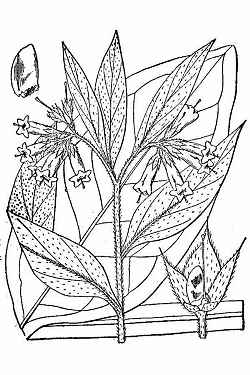
Symphytum officinale, Britton, N.L., and A. Brown. 1913. Illustrated flora of the northern states and Canada. Vol. 3: 92.
Sunset®: All zones
USDA: 3-10
Sun Exposure: Full sun to part shade
Origin: Eurasia
Growth Habits: Herbaceous perennial, up to 3 feet tall (90 cm); stiff hairs covering much of the plant; winged stems; large dark brown to black roots, pure white inside.
Watering Needs: Regular water
Propagation: root cuttings, seeds
The comfrey has medicinal capabilities. It is supposed to speed up healing and bone repairs. The plant is often considered edible although some authors report leaves as being poisonous. The dry leaves have been used to make herbal tea.
Blooming Habits:
Light pink to white flowers.
Culture:
The comfrey sprouts readily from root segments, it is often invasive and hard to eradicate.
Desert-Tropicals is dedicated to provide gardening advice, gardening ideas, and information about flower of all kind for landscape and collections.We try to check carefully the identification of the plants on the illustrations as well as the other information from the page, but occasionally errors do occur. if you notice anything that needs to be changed please contact us.Thanks.
© 1998-2020 Philippe Faucon, All Rights Reserved.